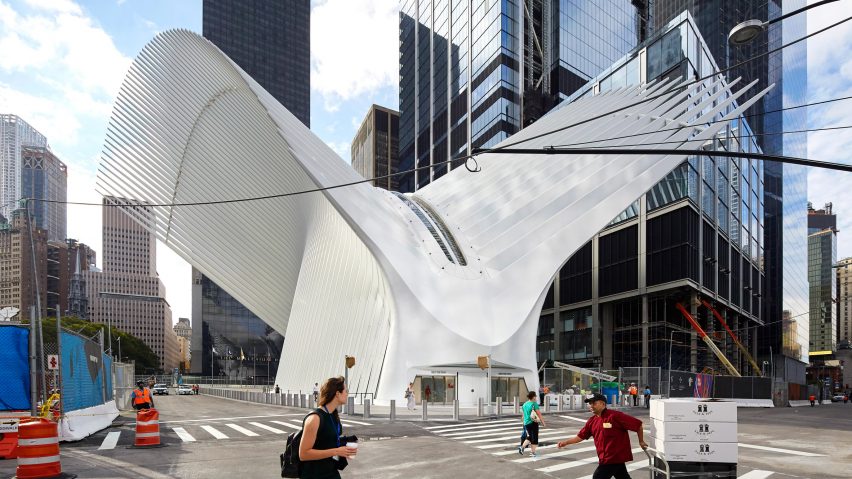
Santiago Calatrava's World Trade Center Oculus continues to leak
Spanish architect Santiago Calatrava's transportation hub at New York's World Trade Center has sprung another leak, but so far no one is taking responsibility.
The building, known as the Oculus, started to let in water after an intense downpour of rain that took place in New York City in early May this year.
As with a leak in 2015, operators The Port Authority of New York and New Jersey blamed the problem on the open construction site of Richard Rogers' Three World Trade Center tower above.
"Somehow water is getting into open areas of Three World Trade Center, leaking into Tower Three," spokesman Steve Coleman told the New York Post.
"Once it leaks into lower levels, all those areas below ground are interconnected. And if you look at the areas of leaks, they're under the Tower Three footprint," he said.
But Three World Trade Center developer, Silverstein Properties, has denied responsibility and thrown the blame back over to The Port Authority.
"It is not true," Silverstein Properties spokesperson Dara McQuillan told Dezeen. "Three World Trade Center has not caused any leaks in the Oculus or any of the Port Authority's projects at the World Trade Center."
Silverstein Properties explained that the tower by UK firm Rogers Stirk Harbour + Partners, which abuts the Oculus, is almost completely enclosed and therefore not capable of causing the leaks.
"Three World Trade Center is 80 floors high and almost completely enclosed in glass and steel," said the developer. "All of the areas impacted by rainwater are parts of the Port Authority's projects, built and operated by the Port Authority."
Calatrava designed the vast ribbed structure to serve as the main terminal for the transport hub, with the intention to bring light down into the subterranean pathways, which connect to rail and subway lines and are lined with commercial space.
It is one of a cluster of buildings on the 16-acre (6.5 hectare) World Trade Center site in Lower Manhattan, including One World Trade Center tower by Skidmore, Owings & Merrill, Four World Trade Center tower by Fumihiko Maki, and the September 11 Museum by Snøhetta and Davis Brody Bond.
The main leaks began on 5 May 2017 and were documented by evacuated commuters on social media. Another rainstorm took place later in the month, but The Port Authority denied that there were any leaks as a result, despite an eye-witness account from a New York Post reporter.
"There were no leaks in the Oculus this week," spokesman Steve Coleman said in a statement released on Friday 29 May 2017.
However, a maintenance worker also told the Post said that leaks often occur following heavy rainfall. It makes the marble floor slippery and dangerous as a result.
"People do have accidents," they said. "Like the last rainy day, somebody almost broke their neck here on the marble."
The Port Authority also blamed the construction of Three World Trade Center for leaks that occurred in 2015, which delayed the completion of the terminal.
The structure quietly opened in March 2016, more than a decade after work at a cost of $4 billion (approximately £3.1 billion). At the time, the exterior was completed but parts of the interior were unfinished.
The Port Authority said the building would finally complete later that year, but reports suggest that parts are still being finished. White panels above doorways can be seen temporarily taped up with white duct tape.
"Everything is not done so you have to come back and do it," a construction worker told the New York Post. "They just wasted a lot of cash over here."
"This should have been done," he continued. "If they just took their time and got it right the first time, we wouldn't have this problem."
The World Trade Center Transportation Hub is not the first of Calatrava's buildings to cause controversy. In 2013, the owners of the Ysios winery he designed in Spain launched legal action, demanding the architect paid part of the £1.7 million needed to fix the building's leaky roof.
The City of Valencia also threatened to sue the architect after parts of the opera house roof at his City of Arts and Sciences complex began falling off just eight years after completion.
Dezeen contacted The Port Authority of New York and New Jersey for further comment but is yet to receive a response.
Photograph is by Hufton + Crow.